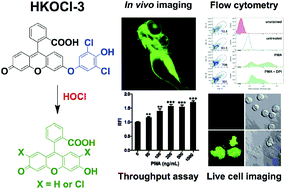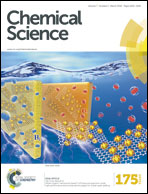HKOCl-3: a fluorescent hypochlorous acid probe for live-cell and in vivo imaging and quantitative application in flow cytometry and a 96-well microplate assay†
Abstract
Ultra-selective and ultra-sensitive probes for hypochlorous acid (HOCl), one of the most poorly understood reactive oxygen species (ROS), are urgently needed to unravel the HOCl functions in important biological processes such as development and innate immunity. Based on a selective oxidative O-dearylation reaction of 2,6-dichlorophenol toward HOCl over other reactive oxygen species, we have developed a novel fluorescent probe HKOCl-3 for HOCl detection with ultra-selectivity, ultra-sensitivity and a rapid turn-on response. The functional robustness of HKOCl-3 for endogenous HOCl detection and imaging has been thoroughly scrutinized in multiple types of phagocytes and in vivo imaging of live intact zebrafish embryos. Furthermore, HKOCl-3 has been successfully applied to the detection of endogenous HOCl by a 96-well microplate assay and flow cytometry. Therefore, HKOCl-3 holds great promise as a versatile molecular tool that enables innovative investigation of HOCl biology and ROS-related diseases in multiple detection modalities.


 Please wait while we load your content...
Please wait while we load your content...